Jen Black's Blog, page 89
November 24, 2013
Writing Processes Blog Tour
My thanks go to Lindsay Townsend for getting touch about this Blog Tour. I've probably given her hives as I dithered about taking part, contacting other writers and generally messing about. Like most things, once I stopped bleating and got down to it, it was easier to do than I thought. Lindsay is a very successful writer of historical novels and romances, and truly deserves your attention. Go to her website and see her fantastic list of titles, and read how she answered the blog tour questions. The link is:
http://www.lindsaytownsend.net
So, on to the questions :
What am I working on?
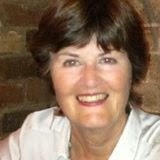 Depends what day it is. I always seem to be playing catch up - if it's not time for a blog post, it's time for promo. If not those, then there are crits required by my crit partners and then - there's my book. Well, books. Right now I've just finished polishing two chapters of a work in progress - it is tentatively called Blood Feud, though that may change if no blood is ever shed. It is set in north west Scotland in the eleventh century. It uses the setting and some characters from Far After Gold, one of my early books about Vikings, but their lives have moved on ten years. Oli is now a rebellious teenager who falls in love with the wrong girl and almost begins a Viking war. With luck and a fair wind, it will be published around Christmas time. Right now my two lovelorn characters are approaching Dyflin in a Viking longship and not at all happy to be there.
Depends what day it is. I always seem to be playing catch up - if it's not time for a blog post, it's time for promo. If not those, then there are crits required by my crit partners and then - there's my book. Well, books. Right now I've just finished polishing two chapters of a work in progress - it is tentatively called Blood Feud, though that may change if no blood is ever shed. It is set in north west Scotland in the eleventh century. It uses the setting and some characters from Far After Gold, one of my early books about Vikings, but their lives have moved on ten years. Oli is now a rebellious teenager who falls in love with the wrong girl and almost begins a Viking war. With luck and a fair wind, it will be published around Christmas time. Right now my two lovelorn characters are approaching Dyflin in a Viking longship and not at all happy to be there.I'm also submitting partials to agents for my main historical - To Capture a Queen. This is set in the 16th century, in the court of the Dowager Queen of Scotland, Mary of Guise. She rightly fears Henry of England will take her daughter to England by force if he can, but does not know that my main character is Matho Spirston, is already in Scotland and planning the attempt.
How Does my work Differ from others of its genre?I think my books could be called cross-genre. Not because they blatantly mix science-fiction and history, but because they're a little more than romance. A reviewer once said Dark Pool was a bit gruesome for a true romance - but she loved it anyway! I like my heroines to face reality, and in historicals, that translates as danger. I'd like men and women to read my books, too. It may be a faint hope, but there you go.
I understand that religion, superstition and that dreaded word ritual, so beloved of archaeologists, figured largely in the ancient world. But I like to give my characters a bit more freedom in their choice of actions. They can believe or not, as they choose. But like most of us today, I don't think ancient man spent days worrying about who made the world. It would be more a case of getting through the day without dying. Right up until the early nineteen hundreds, you could die from sustaining a cut finger, and it would not be a gentle death. I studied History and English at university and I try and keep up with recent research where it touches my stories.
Why Do I Write What I do?Why do you eat chocolate? Because you love it. Because ancient life and times seem so much more interesting to me than modern day stories. With all the books currently flowing out about the Second World War, this is not a good time for me. I want to read about medieval times. I can be quite partisan on certain topics, having been a staunch Richard III supporter since I was a teenager, and believing, like Dorothy Dunnett, that Thorfinn and MacBeth were the same man. Don't tell me Marie Stuart was a fool - I would ask what you would have done differently in her position!
How does your writing process work?
 Life has changed recently for me. I got a puppy. A Dalmatian puppy. Now, pre-puppy, I could write all day if I chose, tinker with blogs and crits or stay in bed until noon. Now, I have a different regime. I'm up reasonably early every day to give my growing dog long walks, whatever the weather. My writing fits around him.
Life has changed recently for me. I got a puppy. A Dalmatian puppy. Now, pre-puppy, I could write all day if I chose, tinker with blogs and crits or stay in bed until noon. Now, I have a different regime. I'm up reasonably early every day to give my growing dog long walks, whatever the weather. My writing fits around him.I don't know where the ideas come from. Reading, I suppose. I read about MacBeth (who hasn't read about him?) and that led to The Banners of Alba , my first published book. Often its a location - The Gibside Estate and the sad tale of Mary Eleanor Bowes gave me the idea for Reluctance , and Aydon Castle made me think of Alina Carnaby in Fair Border Bride.
These days I write straight into the computer. The first draft is always a rush to get the story line down, and I go back often - the next day, and again and again, though I know the experts say you should not. My excuse is that the story line changes, and I want to change the name, the heroine's hair colour or the month before I forget that I changed it. It isn't too onerous for the first 6 or 8 chapters, but once there are 50,000 words to go through, I admit defeat and leave it for the Second Draft. You know, the serious kind that requires so much effort it merits capital letters.
I research as I go, using Google Earth to track the location, and all the other wonderful texts available to us writers these days. It would be silly not to, when they're there at the click of a button.Sometimes I use timelines. I have drafted out entire storylines as advised by Donald Maass and sometimes I've written stories without planning much at all. Whatever it is I do, I do it all in silence. Don't want or need music - just the pictures in my head.If my husband pushes sandwiches and coffee through the door at regular intervals, I'm happy in my own little world. Since you are reading this on my blog, I can only suggest that you click on the page detailing my book titles!
So - don't forget to visit Lindsay's blog, and next week there will be more ~
Next week, on Monday 2nd December, please visit the following authors to see their part of the Writing Process Blog Tour.
Rosemary Morris
Bio:
Historical novelist Rosemary Morris was born in 1940 in Sidcup, Kent.While working in a travel agency, she met her Indian husband who encouraged her to continue her education at Westminster College. In 1961 Rosemary and her husband, now a barrister, moved to his birthplace, Kenya, where she lived from 1961 until 1982. After an Attempted coup d'etat, she and four of her children lived in an ashram in France. Her book shelves are so crammed with historical non-fiction which she uses to research her novels that if she buys a new book she has to consider getting rid of one.
Rosemary's blog is here:
www.rosemarymorris.co.uk
Anita Davison
Bio:
Anita is the author if Royalist Rebel, the story of Elizabeth Murray, countess Dysart, who survived the English Civil War, married to keep her inheritance, and spied for her king in a land where Oliver Cromwell's army persecuted her kind. She has had two other 17th century family saga novels published and two Victorian Romances - Trencarrow Secret and Culloden Spirit from MuseItUp publishing which will be available in paperback early next year. She is now writing historical cozy mysteries and lives in Cheltenham with her extended family, and contemplating adding a dog to the chaos.
Facebook: https://www.facebook.com/anita.davison
Twitter: https://twitter.com/AnitaSDavison
Goodreads: https://www.goodreads.com/author/show/1027164.Anita_Davison
Anita's blog is here:
http://thedisorganisedauthor.blogspot.com
Published on November 24, 2013 18:00
November 23, 2013
Black Hole Country
 A short walk already completed and a cup of coffee by my hand and I'm ready to go at 9.30 on a Saturday morning. Amazing.
A short walk already completed and a cup of coffee by my hand and I'm ready to go at 9.30 on a Saturday morning. Amazing.I intended to do this yesterday, but got sidetracked by attending a Writers' group meeting at Ashington, where we had a lovely lunch, a good discussion and put some good plans in place for a Writers' Retreat Day in May 2014. The lunch was remarkable for its variety and quality - there was one unforgettable lunch where fourteen people all decided to bring a quiche!
The only trouble is that the region east of Newcastle, between Newcastle and the coast, is rather like a Black Hole/Bermuda Triangle for me in the sense that I inevitably get lost either going, or returning and sometimes both. The same thing happened when I was lucky enough to share a ride in Hazel's car. We arrived happily in very good time and full of confidence decided we didn't need the sat nav for the way home. Mistake! We got snarled up in heavy traffic coming through Gosforth, a suburb of Newcastle, and I didn't get home until almost four o'clock. There was only just time to take the dog for a swift walk, before I typed up the notes of the meeting before I forgot the detail and then the clock and dh's stomach suggested it was time to begin preparing a meal.
Which is why I'm really pleased to have a good chunk of working space in front of me now. I left my hero/heroine wet and bedraggled in a Viking longship about to sail up the Liffey to Dublin, (called Dyflin in that period) and I want to get back to them before they catch cold.
Published on November 23, 2013 01:49
November 19, 2013
Days gone by
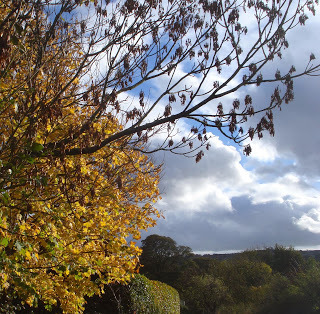 I never seem to have enough time these days. My blog used to be as regular as clockwork but it is a trifle hit and miss now, though I still try to keep to three posts a week. Today I'm in the unusual situation of having time to do it and groping for subject matter. Most frustrating.
I never seem to have enough time these days. My blog used to be as regular as clockwork but it is a trifle hit and miss now, though I still try to keep to three posts a week. Today I'm in the unusual situation of having time to do it and groping for subject matter. Most frustrating.We had the first frost of autumn last night. There might have been a tentative frost earlier in October, but it was so tentative it didn't last til midday. When I took Tim down to the river bank today, the ground was frozen. It's been soft and squishy up until yesterday and while Tim romped about and got muddy, I had to keep my eyes on where I put my feet. I still slipped a few times, but didn't go down. Tim, on the other hand, hit a puddle at full speed this morning and skidded off to one side. He came back to sniff the ice, so no doubt he knows what to expect next time.
This sort of weather makes me very glad to be living in the 21st century. I tell myself a Viking hallhouse could be very cosy with the central hearth blazing and everyone wrapped up in furs to keep warm while the harper told a tale or two. But someone had to go out and find the wood or peat, drag it back and keep the fire burning night and day. Someone had to go hunting so there was something to cook and eat. Trudging through snow in leather boots without the thick, textured soles that we're so used to today would be no picnic. Maybe they packed straw and wool inside to add insulation, but there must have been many frozen toes, chilblains and even frost bite.
People complained of chilblains in the fifties, (a painful, itchy swelling on the hands and feet due to poor circulation and exposure to cold) and scorch marks on the skin over the shins from sitting too close to the fire. These things were not unusual even in the early sixties. No doubt they were common in Viking days as well. Nowadays, does anyone under forty know of chilblains? Do they remember running to the kitchen to make a hot drink before hurrying back to the one warm room in the house? A trip outside to the coalhouse to get more coal - no one wanted to do it, and it usually fell to the man of the house. Going to an icy bed was unthinkable without a hot water bottle, and three people in a bed doesn't seem such a bad idea in context of ye olden days. Body heat times three was not to be sniffed at. Pity those who had outside loos....all these discomforts are mostly forgotten now. But it is life as it was lived in historical novels.
Published on November 19, 2013 05:20
November 16, 2013
Off the beaten track
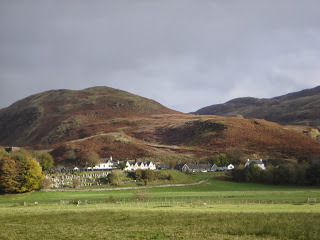 Here we are in November and still there are mild days when it is easy to work up a sweat walking the dog. The weather forecasters promise a dip in temperatures by next week. It will be interesting to see if they are right. I have all my cold weather gear lined up and ready to go.
Here we are in November and still there are mild days when it is easy to work up a sweat walking the dog. The weather forecasters promise a dip in temperatures by next week. It will be interesting to see if they are right. I have all my cold weather gear lined up and ready to go.Last night we went for a meal with friends and visited High House Farm Brewery near Matfen. A microbrewery started up there in 2001 and we visited the brewery and did the tour in October. Here's the link: http://www.highhousefarmbrewery.co.uk/
It is well off the beaten track, though only half a mile as the crow flies from the Roman Wall. I wonder how many walkers would benefit from a refreshing pint if only they knew it was there? We drove the last couple of miles on single track roads between high hedges, and all around was darkness. Would it be open? Had they forgotten our booking? We were almost on the place before we saw a light beaming through the blackness. We got out of the car and almost got blown away - the buildings sit high on the ridge, very much exposed to the weather.
Inside it was warm and welcoming though we were the only party expected that night. Wooden floors and stone walls, cowhide throws over the leather sofas, wooden stairs that creaked alarmingly on every tread. That's old buildings for you. Evidently it is a very popular wedding venue - they're booked solid for next year. I ordered haddock fishcakes with rocket salad and Lemon and Thyme risotto to follow. All very tasty and I for one shall return. I think some might prefer a busier, buzzier place, but I didn't mind our party being the only four people there. Matfen Hall Chapter Library, which we visited in October when David and Helen were with us, was vast, ornate and a little daunting when we were the only guests with at least half a dozen waiters in attendance, but this room was a nice size. I wonder why it is that we keep selecting places where we are the only diners? Can it be that people in general don't eat out as much as they once did? Perhaps the recession means there's not enough spare cash around.
The picture is one I took on our two day break not so long ago. It is Kilmartin, in Argyll. Famous for its prehistoric cairns, chambers and other remains. If prehistory interests you, then here's a link to get you started:
http://www.visitscotland.com/info/towns-villages/kilmartin-p235211
Published on November 16, 2013 07:24
November 12, 2013
Finding the light
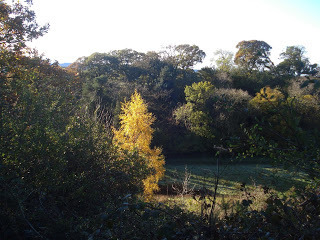 Once in a while I come across a post on someone else's blog that I know I will want to re-read at some point. when I was new to blogs I thought I could always go back and re-read the original, but several times I never found what I was seeking, so now I paraphrase and jot down here the important bits I want to remember. I smiled when I read how
Once in a while I come across a post on someone else's blog that I know I will want to re-read at some point. when I was new to blogs I thought I could always go back and re-read the original, but several times I never found what I was seeking, so now I paraphrase and jot down here the important bits I want to remember. I smiled when I read howhttp://madwomanintheforest.com/ goes through eight drafts. Aha, I thought, I like this woman. I felt even better when she said that nobody writes a publishable first draft.
She specifies two types of revision - one for the Logic of the story she is telling, and the other for Polish. Beginning with the Logic, which is so basic, she lists the scenes of each chapter on a big sheet of paper - something I do on a big spiral-bound art paper book. (I gave up water-colour painting when I started writing, so I already had the big book going spare...) Then on the left side of the paper, she lists the date and time of the action. To the right, she places an arrow to indicate if the scene ends on a positive or negative note for the main character.
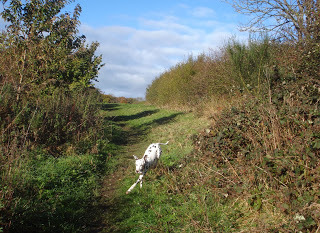
It takes time, but you end up with an overview of your story. What you do then is look to see if anything is misplaced in time or emotional impact. It goes without saying that if you find any, you rectify the problem.
The next task is to look for scenes you could remove without impacting on your story. As a guide, ask yourself if the scene moves the action forward or adds to the reader's understanding of the character. If it doesn't do either, remove the scene. (If you really hate to do that, try and make changes that will better our understanding of the character or move the action forward.)
Then, draw a line through the scenes you plan to remove.
This is good advice. Initially I ripped scenes out, yes, actually deleted them, and felt very brave and in control. Some time later I wished I had kept them in a separate file somewhere, as I could have used them, or part of them, elsewhere. It's called learning the hard way.
Now what you do is read through your list. Check for repetition of words, phrases and reiteration of the same emotional point. Check for scenes that drag, take note and later work on smartening the pace. Check that you use location to the best advantage. Would a different location work better? Check for scenes that fall into the talking heads trap and if you find any, give the characters some action.
Published on November 12, 2013 04:30
November 7, 2013
Amazon's latest deal
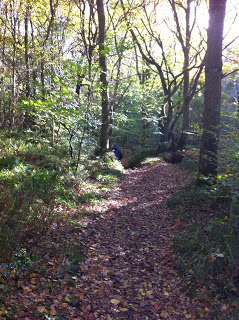
Have you heard that a new deal allows independent booksellers to sell Kindles and get a 10% commission on e-book sales with that device for up to 2 years after the sale?
Called Amazon Source, this deal is only available in the US so far, but there are suspicions that it won't be long before it moves across the Atlantic.
Tim Walker of Walker bookshops wonders why Amazon have taken this step, and suggests that selling Kindle devices would simply help convert people to using Kindles.
David Dawkins manages Pages of Hackney. he won't stock the Kindle and wouldn't want his customers to think he as trading with the bad guys.
Sheila O'Reilly of Dulwich Books thinks she couldn't morally stock Kindles because the company does not pay appropriate taxes in this country.
Jane Streeter of the Bookcase thinks it was inevitable that Amazon wants to partner the independents because Kobo offered a similar service. The 10% commission offered by Amazon is said to be a little higher than Kobo's offer.
Lisa Campbell's article quotes opinions of bookshop owners that I believe operate in the south, possibly all in London - though I have not checked this to be sure. My thought is that there may be many small independents in the midlands and the north who will be so close to closure that they will clutch at this as a lifeline when and if it is offered. Perhaps for that, Amazon deserves some credit? What do you think? At the very least I have a smidgen of admiration for the company that keeps on coming up with new ideas.
Here's the link to the article:
http://www.thebookseller.com/news/uk-indies-we-wont-stock-kindle.html?utm_source=twitterfeed&utm_medium=twitter
Published on November 07, 2013 02:44
November 4, 2013
Amazon's Countdown Deals
 Amazon have hatched a new scheme called Kindle Countdown Deals. This means books are on discount for a few days, and then gradually rise to the original price. It's an interesting strategy, and one wonders if it will work. I suppose it means checking Amazon every day to see what is on offer. Now that won't be bad for them, but it certainly could get tedious for someone like me.
Amazon have hatched a new scheme called Kindle Countdown Deals. This means books are on discount for a few days, and then gradually rise to the original price. It's an interesting strategy, and one wonders if it will work. I suppose it means checking Amazon every day to see what is on offer. Now that won't be bad for them, but it certainly could get tedious for someone like me.I checked the Top Hundred Free titles on Amazon for a few weeks but now hardly remember to go there. It's a hitty-missy kind of exercise - certain authors go free for a day or two, and if you're lucky, you catch their book for free. There's a lot of self-published stuff there that might have benefited from a copy-editor's red pen, but every now and then there is a little nugget of gold. I discovered Ken McClure and Shirley McKay that way, and got a copy of Yan Martel's Life of Pi for 20p.
This has reminded me that it is about time I put one of my own titles up for a free day or two. It usually generates lots of interest, but I find it hard to tell if the exercise generates sales. If I do it soon, it may prompt Amazon US into sending me the next US cheque!
Published on November 04, 2013 18:00
November 2, 2013
Fiction Bestsellers
I've always known that authors writing school text books were on to a good thing. I've frequently tried to get dh to write the definitive text on auto engineering, to no avail. I've even quoted facts at him, such as did he know that the man who created the Mr Men series of kids books reached no 2 on the list of authors who sold the most books between 2000-2009? I added that at number 7 is the author of hundreds of study guides that have earned him a staggering £49 million. (Ah, correction - the article in the Telegraph says they study guides have taken £49 million at the tills, so maybe the author did not receive all of it.)
The chart listing the top hundred books of the decade is equally interesting when we look at fiction. For all the sideswipes over the years at Enid Blyton's books, she is present at number 10. Even more surprising is the fact that Jamie Oliver's cook books make him second in earnings to J K Rowling and put him ahead of Dan Brown. (What is it about that rapidly expanding young man that makes him so much more successful than say James Martin or Nigel Slater? I wish I knew, for I find his "whack it in" style of dialogue irritating.)
J K, by the way, has sold 29 million books with a sales value of 215 million. I don't suppose she got all of that, but still, what she did receive would be a hefty sum. Dan Brown's Da Vinci Code was the most successful single title with 5.2 million copies sold. It is worth studying the list for the unexpected. Lyn Andrews, for example - a shy, gentle lady I heard speak in Corbridge just last year has sold copies that garnered £9.2 million. I bought just four authors in the list - numbers 15,70, 72 and 100.
If you want to read Brian MacArthur's full article, here's the link:
http://www.telegraph.co.uk/culture/books/6866648/Bestselling-authors-of-the-decade.html
and here's the list:Author, Voume Sold, Value1 J K Rowling 29,084,999 £225.9m2 Roger Hargreaves 14,163,141 £26.6m3 Dan Brown 13,372,007 £74.1m4 Jacqueline Wilson 12,673,148 £69.9m5 Terry Pratchett 10,455,397 £77.2m6 John Grisham 9,862,998 £65.9m7 Richard Parsons 9,561,776 £49.2m8 Danielle Steel 9,119,149 £51m9 James Patterson 8,172,647 £53.8m10 Enid Blyton 7,910,758 £31.2m11 Bill Bryson 7,409,656 £61.2m12 Patricia Cornwell 7,355,180 £49.8m13 Jamie Oliver 7,244,620 £89.5m14 Daisy Meadows 7,149,788 £24.1m15 Ian Rankin 6,848,039 £44.3m16 Julia Donaldson 6,621,594 £33.7m17 Alexander McCall Smith 6,609,779 £40.6m18 Francesca Simon 6,564,681 £31.6m19 Bernard Cornwell 6,297,911 £45.5m20 Roald Dahl 6,169,406 £33.8m21 Martina Cole 6,021,960 £41.7m22 Philip Pullman 5,544,376 £35.8m23 Stephenie Meyer 5,487,313 £32m24 Maeve Binchy 5,476,134 £37.6m25 J R R Tolkien 5,280,406 £50.6m26 Delia Smith 5,269,783 £58.7m27 Stephen King 5,268,577 £38m28 Marian Keyes 5,029,363 £31.7m29 Jeremy Clarkson 4,913,989 £35.1m30 Josephine Cox 4,651,166 £24m31 Sophie Kinsella 4,528,095 £27.7m32 Jodi Picoult 4,514,620 £24.1m33 Terry Deary 4,495,655 £21.6m34 Anthony Horowitz 4,304,041 £23.6m35 Lemony Snicket 4,220,508 £23.9m36 Andy McNab 4,123,633 £30.4m37 Ian McEwan 4,040,887 £27.7m38 Wilbur Smith 3,871,484 £30.1m39 Michael Connelly 3,785,330 £23.5m40 Sebastian Faulks 3,782,665 £27.5m41 Kathy Reichs 3,514,087 £22.2m42 Helen Fielding 3,473,003 £22m43 Cecelia Ahern 3,422,899 £19.5m44 Joanne Harris 3,392,198 £21.2m45 William Shakespeare 3,333,670 £17.8m46 Carol Vorderman 3,315,641 £11.2m47 Chris Ryan 3,289,855 £21m48 Lee Child 3,274,928 £20.2m49 Dave Pelzer 3,217,905 £20.2m50 R L Stine 3,096,584 £13.1m51 Catherine Cookson 3,020,751 £16.8m52 Dean Koontz 3,010,242 £17.5m53 W Awdry 2,991,572 £9.9m54 Michael Morpurgo 2,989,161 £15.1m55 Jeffery Deaver 2,972,145 £16.9m56 Khaled Hosseini 2,957,026 £21.1m57 Nick Hornby 2,956,544 £19.6m58 Ben Elton 2,907,294 £20m59 Katie Price 2,856,697 £21.8m60 Jill Mansell 2,798,518 £14.2m61 Mark Haddon 2,783,600 £16.8m62 Lucy Daniels 2,768,332 £11.2m63 Dr Seuss 2,760,156 £14.8m64 Tess Gerritsen 2,745,556 £14.7m65 Tony Parsons 2,731,436 £17.3m66 Alan Titchmarsh 2,707,834 £27.5m67 Harlan Coben 2,672,713 £15.1m68 Lauren Child 2,632,369 £13.4m69 Darren Shan 2,617,959 £14.4m70 Nigella Lawson 2,616,955 £39.2m71 Robert C Atkins 2,591,073 £17.3m72 Philippa Gregory 2,577,235 £17.4m73 Jane Green 2,498,100 £14.8m74 Clive Cussler 2,435,718 £16.5m75 Fiona Watt 2,431,376 £14.1m76 Cathy Kelly 2,391,540 £13.2m77 Penny Vincenzi 2,358,041 £14.6m78 Charles Dickens 2,341,980 £9.3m79 Eric Hill 2,334,612 £12.1m80 Joanna Trollope 2,333,337 £14.5m81 Meg Cabot 2,309,844 £12.1m82 Jackie Collins 2,295,308 £14.4m83 Lesley Pearse 2,261,007 £12.6m84 A A Milne 2,255,346 £14.5m85 Paulo Coelho 2,229,564 £16.3m86 Eric Carle 2,225,336 £12.1m87 Louis de Bernières 2,221,481 £15.3m88 Jack Higgins 2,207,100 £12.4m89 Anita Shreve 2,198,899 £13.4m90 Karin Slaughter 2,196,031 £12.6m91 Louise Rennison 2,172,395 £11.9m92 Sheila O’Flanagan 2,162,811 £10.8m93 Robert Harris 2,150,818 £16m94 Paul McKenna 2,114,476 £16.6m95 Alice Sebold 2,106,630 £13.2m96 Gordon Ramsay 2,094,376 £23.4m97 Roderick Hunt 2,077,092 £7.3m98 Frank McCourt 2,055,939 £14.9m99 Dav Pilkey 2,051,622 £9.4m100 Lyn Andrews 2,027,382 £9.2m
Did any names on that list surprise you?
The chart listing the top hundred books of the decade is equally interesting when we look at fiction. For all the sideswipes over the years at Enid Blyton's books, she is present at number 10. Even more surprising is the fact that Jamie Oliver's cook books make him second in earnings to J K Rowling and put him ahead of Dan Brown. (What is it about that rapidly expanding young man that makes him so much more successful than say James Martin or Nigel Slater? I wish I knew, for I find his "whack it in" style of dialogue irritating.)
J K, by the way, has sold 29 million books with a sales value of 215 million. I don't suppose she got all of that, but still, what she did receive would be a hefty sum. Dan Brown's Da Vinci Code was the most successful single title with 5.2 million copies sold. It is worth studying the list for the unexpected. Lyn Andrews, for example - a shy, gentle lady I heard speak in Corbridge just last year has sold copies that garnered £9.2 million. I bought just four authors in the list - numbers 15,70, 72 and 100.
If you want to read Brian MacArthur's full article, here's the link:
http://www.telegraph.co.uk/culture/books/6866648/Bestselling-authors-of-the-decade.html
and here's the list:Author, Voume Sold, Value1 J K Rowling 29,084,999 £225.9m2 Roger Hargreaves 14,163,141 £26.6m3 Dan Brown 13,372,007 £74.1m4 Jacqueline Wilson 12,673,148 £69.9m5 Terry Pratchett 10,455,397 £77.2m6 John Grisham 9,862,998 £65.9m7 Richard Parsons 9,561,776 £49.2m8 Danielle Steel 9,119,149 £51m9 James Patterson 8,172,647 £53.8m10 Enid Blyton 7,910,758 £31.2m11 Bill Bryson 7,409,656 £61.2m12 Patricia Cornwell 7,355,180 £49.8m13 Jamie Oliver 7,244,620 £89.5m14 Daisy Meadows 7,149,788 £24.1m15 Ian Rankin 6,848,039 £44.3m16 Julia Donaldson 6,621,594 £33.7m17 Alexander McCall Smith 6,609,779 £40.6m18 Francesca Simon 6,564,681 £31.6m19 Bernard Cornwell 6,297,911 £45.5m20 Roald Dahl 6,169,406 £33.8m21 Martina Cole 6,021,960 £41.7m22 Philip Pullman 5,544,376 £35.8m23 Stephenie Meyer 5,487,313 £32m24 Maeve Binchy 5,476,134 £37.6m25 J R R Tolkien 5,280,406 £50.6m26 Delia Smith 5,269,783 £58.7m27 Stephen King 5,268,577 £38m28 Marian Keyes 5,029,363 £31.7m29 Jeremy Clarkson 4,913,989 £35.1m30 Josephine Cox 4,651,166 £24m31 Sophie Kinsella 4,528,095 £27.7m32 Jodi Picoult 4,514,620 £24.1m33 Terry Deary 4,495,655 £21.6m34 Anthony Horowitz 4,304,041 £23.6m35 Lemony Snicket 4,220,508 £23.9m36 Andy McNab 4,123,633 £30.4m37 Ian McEwan 4,040,887 £27.7m38 Wilbur Smith 3,871,484 £30.1m39 Michael Connelly 3,785,330 £23.5m40 Sebastian Faulks 3,782,665 £27.5m41 Kathy Reichs 3,514,087 £22.2m42 Helen Fielding 3,473,003 £22m43 Cecelia Ahern 3,422,899 £19.5m44 Joanne Harris 3,392,198 £21.2m45 William Shakespeare 3,333,670 £17.8m46 Carol Vorderman 3,315,641 £11.2m47 Chris Ryan 3,289,855 £21m48 Lee Child 3,274,928 £20.2m49 Dave Pelzer 3,217,905 £20.2m50 R L Stine 3,096,584 £13.1m51 Catherine Cookson 3,020,751 £16.8m52 Dean Koontz 3,010,242 £17.5m53 W Awdry 2,991,572 £9.9m54 Michael Morpurgo 2,989,161 £15.1m55 Jeffery Deaver 2,972,145 £16.9m56 Khaled Hosseini 2,957,026 £21.1m57 Nick Hornby 2,956,544 £19.6m58 Ben Elton 2,907,294 £20m59 Katie Price 2,856,697 £21.8m60 Jill Mansell 2,798,518 £14.2m61 Mark Haddon 2,783,600 £16.8m62 Lucy Daniels 2,768,332 £11.2m63 Dr Seuss 2,760,156 £14.8m64 Tess Gerritsen 2,745,556 £14.7m65 Tony Parsons 2,731,436 £17.3m66 Alan Titchmarsh 2,707,834 £27.5m67 Harlan Coben 2,672,713 £15.1m68 Lauren Child 2,632,369 £13.4m69 Darren Shan 2,617,959 £14.4m70 Nigella Lawson 2,616,955 £39.2m71 Robert C Atkins 2,591,073 £17.3m72 Philippa Gregory 2,577,235 £17.4m73 Jane Green 2,498,100 £14.8m74 Clive Cussler 2,435,718 £16.5m75 Fiona Watt 2,431,376 £14.1m76 Cathy Kelly 2,391,540 £13.2m77 Penny Vincenzi 2,358,041 £14.6m78 Charles Dickens 2,341,980 £9.3m79 Eric Hill 2,334,612 £12.1m80 Joanna Trollope 2,333,337 £14.5m81 Meg Cabot 2,309,844 £12.1m82 Jackie Collins 2,295,308 £14.4m83 Lesley Pearse 2,261,007 £12.6m84 A A Milne 2,255,346 £14.5m85 Paulo Coelho 2,229,564 £16.3m86 Eric Carle 2,225,336 £12.1m87 Louis de Bernières 2,221,481 £15.3m88 Jack Higgins 2,207,100 £12.4m89 Anita Shreve 2,198,899 £13.4m90 Karin Slaughter 2,196,031 £12.6m91 Louise Rennison 2,172,395 £11.9m92 Sheila O’Flanagan 2,162,811 £10.8m93 Robert Harris 2,150,818 £16m94 Paul McKenna 2,114,476 £16.6m95 Alice Sebold 2,106,630 £13.2m96 Gordon Ramsay 2,094,376 £23.4m97 Roderick Hunt 2,077,092 £7.3m98 Frank McCourt 2,055,939 £14.9m99 Dav Pilkey 2,051,622 £9.4m100 Lyn Andrews 2,027,382 £9.2m
Did any names on that list surprise you?
Published on November 02, 2013 19:00
November 1, 2013
Artistic Crinan
 I took this pic from the hotel window. Our bedroom window (third floor, front) looked out over the loch but this view from the gallery shows the lock that joins the canal to the sea. It's buzzing in the summer, when all the yachts are skipping about the west coast and putting in for a good meal at the Seafood Restaurant. The dogs and kids all wear life jackets and everybody looks healthy! some of the ships are beautiful, too.
I took this pic from the hotel window. Our bedroom window (third floor, front) looked out over the loch but this view from the gallery shows the lock that joins the canal to the sea. It's buzzing in the summer, when all the yachts are skipping about the west coast and putting in for a good meal at the Seafood Restaurant. The dogs and kids all wear life jackets and everybody looks healthy! some of the ships are beautiful, too.Two days isn't long enough to do any spectacular, but it was a lovely break. We drove back through a rain storm which only abated as we drove south to England - ha ha, any moral to be gleaned from that, I wonder?
One of the advertising cards calls the hotel a Gallery with rooms....and there are pictures everywhere. The proprietor is an artist by the name of Frances MacDonald and she and her husband Nick Ryan have been resident for 35 years. They hold artists' events, and dh is keen to return when one of them is happening. He has decided to take up painting again on the strength of what he saw in the hotel.
Everybody needs a hobby, so I'm glad he is taking it up again. Mine used to be painting, until I took up writing seriously, and then the painting gradually slid away and got tucked in a drawer. Along with writing came all those other things authors have to do these days - be social on Twitter and Facebook, keep records, keep sending out submissions, keep an eye on the market......
Published on November 01, 2013 13:52
October 30, 2013
Crinan Ferry and Isolation
 We drove a little way to a dead-end one-track road where we could walk a couple of miles to Crinan Ferry and let Tim run off-lead. It is difficult to find places where he can run free when there's livestock about but we were lucky in out choice. The one field of cattle were safely fenced away from him, and the sheep were roaming the shore of the loch.
We drove a little way to a dead-end one-track road where we could walk a couple of miles to Crinan Ferry and let Tim run off-lead. It is difficult to find places where he can run free when there's livestock about but we were lucky in out choice. The one field of cattle were safely fenced away from him, and the sheep were roaming the shore of the loch.There is a little cluster of houses at Crinan Ferry. We guessed a couple of them would be holiday homes. because it is such an idyllic spot, I asked dh if he would like a week's holiday there. 'Not on your life,' he replied. 'I'd be bored stupid.'
It is amazing how some people choose to live in spots so remote that other people couldn't contemplate life there. I've often thought such a life would suit me, but the closest I've ever got to it is holidaying in such places, and that isn't a true test. Now that we all have computers and chatter away online, it could be argued that nowhere is truly remote any more. I know the Western Isles were keen to take up e-communication when it first became available, and had library and school link-ups long before city dwellers really thought about it. Now we chatter with off-spring in Australia every day if we chose to do so.
We reached Crinan Ferry landing but of course there's no ferry now. It ceased operating in eighteen hundred and something, and was only a rowing boat even then. It must have been a day's walk to get to Kilmarti
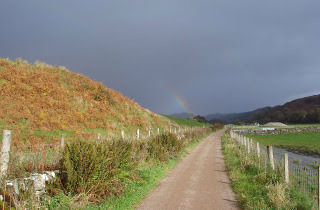 n back then, a village we reached by car in twenty minutes. Perhaps half a day on horseback.
n back then, a village we reached by car in twenty minutes. Perhaps half a day on horseback.The valley in which Kilmartin sits is green and fertile, and it is ea
sy to see why prehistoric people lived there and built their temples and cairns and burial chambers. The Dunadd, they claim, is the seat of the kings of Dal Riata. Literally translated, the Dunadd would be the fortress on the river Add. We climbed it on a previous holiday and searched for the famous footprint. We found it, but didn't think it looked like any foot print we've seen. Or put another way, it was like a lot of other odd shaped holes in rocks you find on the sea shore. But if you want to believe it was part of the coronation ritual of Dalriardan kings, I have no quarrel with you.
http://www.megalithic.co.uk/article.php?sid=342 (a formal reference to the Dunadd)
http://lostfort.blogspot.co.uk/2009/11/sunny-day-in-kilmartin-glen-dunadd-hill.html (An informal visitor record, with photographs.)
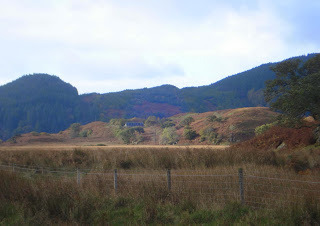
We walked into Kilmartin along the line of the chambered cairns and got drenched in a rain storm before we clambered uphill to reach the Museum and cafe. Because we had Tim, we sat in a small yurt outside the cafe and devoured chocolate cake and drank hot coffee. We had done the museum bit on our last visit, and recommend it to anyone who visits the area. Once the rain cleared, as it does in Scotland, the sun came out and we walked back to the car and drove back to the hotel for a siesta. We needed it. We must have walked about eight or nine miles.
Published on October 30, 2013 04:06
Jen Black's Blog
- Jen Black's profile
- 6 followers
Jen Black isn't a Goodreads Author
(yet),
but they
do have a blog,
so here are some recent posts imported from
their feed.



